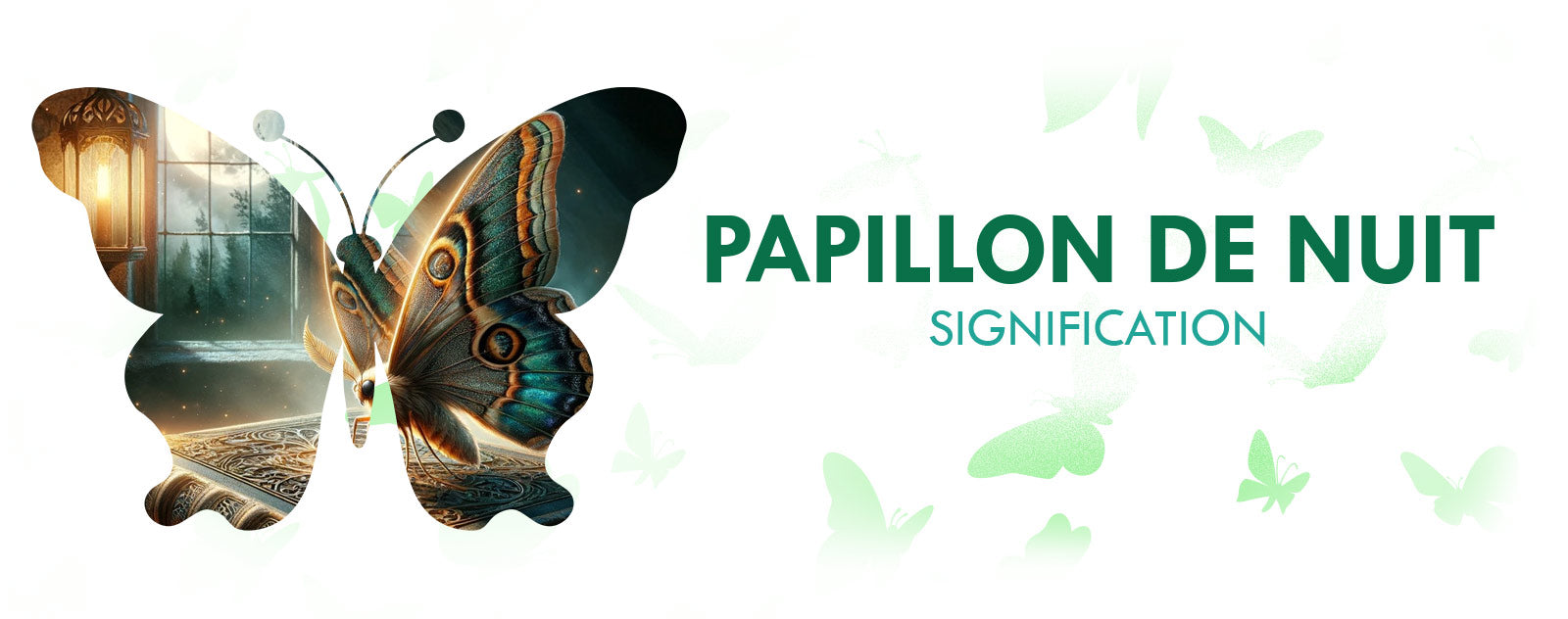Do moths fascinate you? Would you like to know more about these symbolic insects?
This article explores in depth the meaning and symbolism of these nocturnal creatures, while incorporating a diversity of Lepidoptera-related terms to enrich our understanding of these mysterious insects.
And if you are also passionate about butterflies, we invite you to visit butterfly news to discover lots of topics on this magnificent insect!
Without further ado, let's start reading the article!
Symbolic Meanings of Moths Across Cultures
The Universal Symbolism of Moths
Moths are not just creatures of the night, they are loaded with symbolism in various cultures around the world. Here are some of the meanings often attributed to these nocturnal moths:
- Mystery and the Unknown: Due to their nocturnal activity, they are often associated with the mysteries of the night and the unexplored.
- Transformation and Change: As they go through several dramatic transformations from larva to adult, they symbolize change and metamorphosis.
- Death and Rebirth: In some traditions, moths are seen as representatives of the cycle of life, symbolizing both death and spiritual rebirth.
Mythological and Folklore Stories
In many myths, moths are present as spirit guides. For example, among some indigenous peoples of South America, the moth is considered a messenger between worlds. In Europe, the great night peacock with its eye patterns on the wings is often linked to superstitions and legends about the protective or evil gaze.
The Moth in Modern Literature
In contemporary literature, the moth is often used as a symbol of personal transformation, representing the passage from darkness to light or the characters' inner struggle.
Conservation Issues and Human Interactions

Threats and Conservation
Despite their ecological importance, many moth species are in decline due to factors such as:
- Habitat Loss: The destruction of forests and grasslands decreases nesting grounds and food sources for moths.
- Use of Pesticides: Chemicals used in agriculture can be fatal to adult caterpillars and butterflies.
Preservation Initiatives
To combat these threats, several conservation initiatives have been put in place:
- Research Programs: Entomologists study the life cycles and habitats of butterflies to better understand how to protect them.
- Nature Reserves: Protected areas are established to preserve the natural habitats of moths and other endangered species.
- Ecological Restoration Projects: These initiatives aim to restore degraded ecosystems to promote biodiversity, including that of moths.
Awareness and Education
An essential part of moth conservation involves raising public awareness of their role in the environment and the need to protect them. Natural history museums, botanical gardens and school educational programs play a crucial role in educating people of all ages about the importance of moths and other insects.
The Butterfly as Messenger from the Beyond

Belief in Spiritual Messages
In many cultures, moths are considered messengers from the afterlife, carrying news of spirits or the deceased to those living on Earth. This belief is manifested in the way moths are attracted to light, symbolizing the search for truth or revelation.
The Moth in Ceremonies and Rituals
Some traditional rituals use the image of the moth to symbolize the passage of the soul from one world to another. For example, in some indigenous traditions of North America, the moth is invoked to guide the spirits of the deceased during funeral ceremonies.
Psychological Interpretations
In the field of psychology, seeing a moth can be interpreted as a sign that one should pay attention to internal or unconscious messages, often related to aspects of our lives that we neglect or repress.
Moths in Spiritual Literature
Literary works are full of references to moths as symbols of communication with the afterlife. They often appear in contexts where characters are going through periods of transition or deep spiritual introspection.
Butterflies in Mythology and Legends

The Butterfly in Greek Mythology
In Greek mythology, the butterfly is often associated with Psyche, the goddess of the soul, who is depicted with butterfly wings. This association symbolizes the fleeting nature of life and the transformation of the soul after death.
Asian Legends and Butterflies
In Asia, butterflies are often present in legends as symbols of joy, change and resilience. A Japanese legend tells how moths guide the souls of fallen warriors to the afterlife, allowing them to find eternal rest.
Role of Butterflies in Native American Tales
Among Native American peoples, butterflies are often central figures in educational stories, conveying lessons about the need to change and evolve to survive and thrive in the natural world.
Butterflies and European Folklore
In European folklore, moths are often considered omens, announcing either good or bad news depending on their color or the time of their appearance. They are also seen as protectors of homes and gardens at night.
Moths and Their Mystical Metamorphoses
The Life Cycle: From Caterpillar to Moth
Moths, like their diurnal cousins, go through several stages of development: egg, caterpillar (larva), chrysalis (cocoon) and finally, the adult stage. Each phase represents profound transformations. For example, the Bindweed Hawk Moth begins life as a tiny caterpillar that feeds voraciously on host plants such as bindweed, then transforms into a chrysalis before emerging as an adult butterfly. This metamorphosis is often seen as a symbol of rebirth and profound change.
Spiritual and Cultural Symbolism
In many cultures, moths are seen as carriers of messages from the afterlife or symbols of spiritual transformation. The great night peacock, with its wings that bear patterns resembling eyes, is particularly revered in some traditions as a keeper of nocturnal secrets and a spiritual guide.
The Ecological Role of Moths
Despite their inconspicuous nature, moths play a crucial role in ecosystems. They act as pollinators for many plants, often those that open or release nectar at night. The ecological role of species such as the Hummingbird Sphinx, which pollinates flowers with remarkable precision thanks to its long proboscis, is vital for biodiversity.
Diversity and Adaptation of Moths
The Richness of Moth Species
Moths make up an important part of Lepidoptera biodiversity, with thousands of species distributed on every continent except Antarctica. From exotic species like the Moro sphinx to more common species such as the moth, each moth has adapted its wings, often scaled and colorful, to blend into its surroundings, a crucial strategy for avoiding predators.
Adaptations of the Nocturnal Butterflies
Moths have evolved fascinating adaptations to survive. For example, males' feathery antennae are used to detect females' pheromones, sometimes over impressive distances. Others, like the "death's head" moth, are known for their ability to make sounds to escape bats.
Threats and Preservation
Despite their adaptability, many moth species are threatened by habitat loss, pesticide use and climate change. Conservation efforts, such as those undertaken by natural history museums and various NGOs, are essential to preserving these fascinating nocturnal creatures.
Ecological Roles and Interactions with Humans
Pollination and Biodiversity
Moths contribute significantly to the pollination of many plants, which is crucial for plant reproduction and fruit production. This beneficial interaction helps maintain the health of ecosystems and ensures the genetic diversity of plants.
The Moth in Research and Science
Entomologists study moths to better understand the mechanisms of evolution and adaptation. Research on their nocturnal navigation and their resistance to host plant toxins provides valuable insights for areas as varied as
Moths and Their Role in Global Biodiversity
Ecological Importance of Moths
Moths, often less celebrated than their diurnal counterparts, play a crucial role in the biodiversity of their ecosystems. As pollinators, many species of moths assist in the reproduction of flowers, particularly those that open or emit fragrance at night. This allows for the genetic diversification of plants, essential for the resilience of ecosystems.
Moths as Indicators of Ecological Health
Moth populations are often considered indicators of environmental health. Their sensitivity to ecological changes, such as light pollution, pesticide use and habitat degradation, allows scientists to monitor the impact of human activities on the natural environment.
Contribution to the Food Chain
Besides pollination, moths serve as food for a variety of animals, including bats, nocturnal birds, and even some species of large spiders. This predator-prey interaction is vital for maintaining the natural balance of populations in natural environments.
Diversity of Moths
With thousands of butterfly species spread across the world, every habitat features unique species of moths, from deserts to rainforests. This diversity is not only scientifically fascinating but also vital to the robustness of local ecosystems, with each species having developed specific adaptations to survive in its particular environment.
More Information on the Biological Diversity and Importance of Moths
A World of Colors and Shapes
Moths display a staggering variety of shapes, sizes and colors. Here are some notable aspects:
- Colorful Scales: The wings of moths are covered in tiny scales that reflect light in different ways, creating intricate, colorful patterns that are essential for camouflage or communication between species.
- Varied Wing Shapes: From the elegant azure butterfly to the robust sphinx moths, the shape of their wings is adapted to their particular lifestyles, whether nocturnal or twilight.
Remarkable Species and Their Adaptation
Moths have evolved incredible adaptations to survive in varied environments:
- The Bindweed Hawkmoth uses its extremely long proboscis to access the nectar at the bottom of the tubular flowers.
- The Death's Head Moth can emit a cry by expelling air from its mouth to frighten predators and feed on bee hives without being disturbed.
The Ecological Contribution of Moths
Moths play crucial ecological roles in natural habitats:
- Pollinators: Many moths are active pollinators, especially of plants that bloom at night.
- Link in the Food Chain: They serve as food for various animals, such as bats and nocturnal birds.
The Moth is also a Symbol that Expresses Freedom
The Symbolic Freedom of the Flight of the Butterfly
Butterflies, with their ability to fly, symbolize freedom. Their transition from caterpillar chained to the ground to aerial butterfly reflects a profound metamorphosis, representing the passage from the state of constraint to the state of liberation.
Artistic and Creative Inspirations
Artists throughout time have used the image of the butterfly to express themes of freedom and emancipation. In painting, poetry and music, butterflies often inspire works that celebrate independence and the beauty of free expression .
The Symbolism of Moths in Dreams
Dream Interpretations with Moths
Seeing butterflies in dreams is often interpreted as a sign of personal transformation or impending transition in the dreamer's life. Moths, in particular, can symbolize aspects of our personality or life that remain in the shadows or that need attention.
Moths and Unconscious Messages
In the context of dreams, moths can also represent repressed thoughts or feelings. Their appearance suggests that it is time to examine them more carefully to resolve inner questions or emotional conflicts.
Dreams of Metamorphosis and Growth
Dreams of transforming into a butterfly or seeing butterflies emerge from their chrysalis may reflect the dreamer's process of personal growth and spiritual development. These dreams often encourage leaving old habits behind to embrace new opportunities.
Moths as Symbols of Resilience
Finally, dreaming of moths can highlight resilience in the face of life's challenges. Despite darkness or difficulties, the moth continues to fly and seek the light, reminding the dreamer of the ability to persevere and find one's way.
These interpretations enrich our understanding of moths not only as biological entities, but also as bearers of deep and universal meanings. Whether as messengers from the afterlife, symbols of freedom, or inspirers of dreams, moths continue to fascinate and inspire across ages and cultures.
The Moth: a Spiritual Guide for your life
Moths are not just fascinating creatures of the night, they carry a wealth of meanings and symbolism that transcends cultures and times.
Whether seen as messengers from the afterlife, symbols of freedom, key players in myths and legends, or vectors of profound messages in our dreams, moths invite us to explore themes of transformation, resilience, and spirituality. Their presence in our world and in our imaginations enriches our perception of nature and our own existence, constantly reminding us of the beauty and complexity of life.






Dayana
Bonjour Martyn,
Le sphinx à tête de mort, ou Acherontia atropos, est souvent associé à des symboles mystérieux en raison de sa tête marquée d’un motif en forme de crâne. Bien qu’il puisse évoquer des présages, notamment dans certaines cultures qui lui prêtent un caractère symbolique, le voir est plutôt un événement rare et fascinant en raison de sa taille et de ses caractéristiques uniques. Sa présence chez vous n’a probablement pas de signification négative, les papillons de nuit comme celui-ci peuvent être attirés par la lumière et recherchent des lieux calmes pour se poser. Profitez de cette rencontre inhabituelle comme un moment de curiosité naturelle !
Martyn
Bonjour j’ai un sphinx à tête de mort de grande taille qui est entré dans ma maison hier soir, il est ressorti puis est resté quelques temps au plafond de ma terrasse extérieure, que dois-je en penser de ce présage svp
Merci pour votre explication
Dayana
Bonjour Fanny,
Voir un papillon de nuit n’est généralement pas un mauvais présage. Il symbolise souvent l’intuition, le mystère et la transformation intérieure. Sa présence pourrait simplement refléter un moment d’introspection ou de transition.
Dayana
Bonjour Morel,
Les papillons de nuit, surtout avec des couleurs sombres comme le noir, symbolisent souvent l’introspection, les mystères cachés et la transformation intérieure. Le noir représente la profondeur, l’inconnu, et parfois un besoin de se reconnecter avec ses émotions ou sa spiritualité. Le liseré blanc, quant à lui, peut symboliser une lumière ou une clarté qui émerge de cette exploration intérieure. Spirituellement, ces papillons pourraient indiquer un moment de réflexion profonde et de transformation personnelle.
Fanny
Bonsoir je viens de voir sur mon mur de ma chambre un papillon de nuit je ne sais pas vraiment de quelle espèce il était vue qu’il était fermé assez impression j ai su le mettre dehors en le mettant dans une boîte il m avait l’air d une couleur foncé quand même j espère que cela n’est pas un mauvais présage 🙏